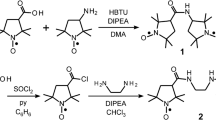Abstract
The EPR spectrum of 2,2,6,6-tetramethylpiperidine-N-oxide (TEMPO) has been systematically investigated in several solvents and in aqueous solutions of glycerol,t-BuOH, Bu4NBr,n-HexNH3Br,n-OctNH3Br, NaBPh4, and Ph4AsCl. Most of the results have been obtained at 25°C, though the temperature dependence of the linewidths has been examined in water and several organic solvents. Data on the spectrum of ditertiarybutylnitroxide in aqueous solutions of glycerol and Bu4NBr are also presented. The spectrum was simulated to determine WH, the linewidth after allowance for the unresolved proton hyperfine interaction, in each manifold of the triplet due to the nitrogen hyperfine interaction. The linewidth WH is analyzed in terms of the reorientational correlation time Äθ and the angular velocity correlation time ÄJ. In most solutions Äθ is determined only by the bulk solution viscosity, except in situations where significant clustering of hydrophobic solute molecules occurs. In pure nonaqueous solvents the temperature dependence results are consistent with ÄJ being determined by the bulk viscosity, while in water or aqueous solutions, a very different behavior is found which is interpreted as a manifestation of clathrate-like hydration of the hydrophobic radical. This interpretation is incorporated in a two-state model developed to account for the WH data of TEMPO in aqueous solutions of various hydrophobic solutes. The equilibrium parameters derived from the model, for the association of TEMPO with several hydrophobic solutes, support the concept of hydrophobic interactions as pictured from thermodynamic excess functions.
Similar content being viewed by others
References
C. Jolicoeur and H. L. Friedman,Ber. Bunsenges, Physik. Chem. 75, 248 (1971).
T. J. T. Buckman, P. L. Nordio, and H. M. McConnell,Proc. Nat. Acad. Sci. 54, 1010 (1965).
E. G. Rozantzev and M. B. Neiman,Tetrahedron 20, 131 (1964).
R. Brière, H. Lemaire, and A. Rassat,Bull, Soc. Chim. France, 3273 (1965).
A. K. Hoffman,J. Am. Chem. Soc. 86, 641 (1964).
Handbook of Physics and Chemistry (The Chemical Rubber Co., Cleveland, 1963), 44th ed.
H. L. Schläfer and W. Schaffernicht,Angew. Chem. 72, 618 (1960).
A. Hudson and H. A. Hussain,J. Chem. Soc. (B), 251 (1968).
J. C. Espie, H. Lemaire, and A. Rassat,Bull. Soc. Chim. France, 399 (1969).
R. Brière, H. Lemaire, A. Rassat, P. Rey, and A. Rousseau,Bull. Soc. Chim. France, 4479 (1967).
R. W. Kreilick,J. Chem. Phys. 46, 4260 (1967).
L. Libertini and O. H. Griffith,J. Chem. Phys. 53, 1359 (1970).
G. Poggi and C. S. Johnson,J. Magnetic Res. 3, 436 (1970).
C. Jolicoeur and H. L. Friedman,J. Phys. Chem. 75, 165 (1971).
J. Oakes,Nature 231, 38 (1971).
D. Kivelson,J. Chem. Phys. 33, 1094 (1960).
P. W. Atkins and D. Kivelson,J. Chem. Phys. 44, 169 (1966); R. E. D. McClung and D. Kivelson,J. Chem. Phys. 49, 3380 (1968).
M. P. Eastman, Ph. D. thesis, Cornell University, New York, 1968.
J. E. Desnoyers and M. Arel,Can. J. Chem. 45, 359 (1967).
H. L. Friedman,J. Phys. Chem. 71, 1723 (1967).
C. Jolicoeur, P. Philip, G. Perron, P. A. Leduc, and J. E. Desnoyers,Can. J. Chem. 50, 3167 (1972).
C. Jolicoeur, N. D. Thé, and A. Cabana,Can. J. Chem. 49, 2008 (1971).
J. J. Kozak, W. S. Knight, and W. Kauzmann,J. Chem. Phys. 48, 675 (1968).
H. S. Gutowsky, D. M. McCall, and C. P. S. Slichter,J. Chem. Phys. 30, 899 (1969).
A. Abragam,The Principles of Nuclear Magnetism (Oxford University Press, London, 1961), pp. 114, 115, 272.
Ibid., p. 300; see also refs. 16 and 17.
F. J. Millero, inWater and Aqueous Solutions, R. A. Horne, ed. (John Wiley and Sons, Inc. New York, 1972), p. 519.
Author information
Authors and Affiliations
Rights and permissions
About this article
Cite this article
Jolicoeur, C., Friedman, H.L. Hydrophobic nitroxide radicals as probes to investigate the hydrophobic interaction. J Solution Chem 3, 15–43 (1974). https://doi.org/10.1007/BF00649494
Received:
Revised:
Issue Date:
DOI: https://doi.org/10.1007/BF00649494




